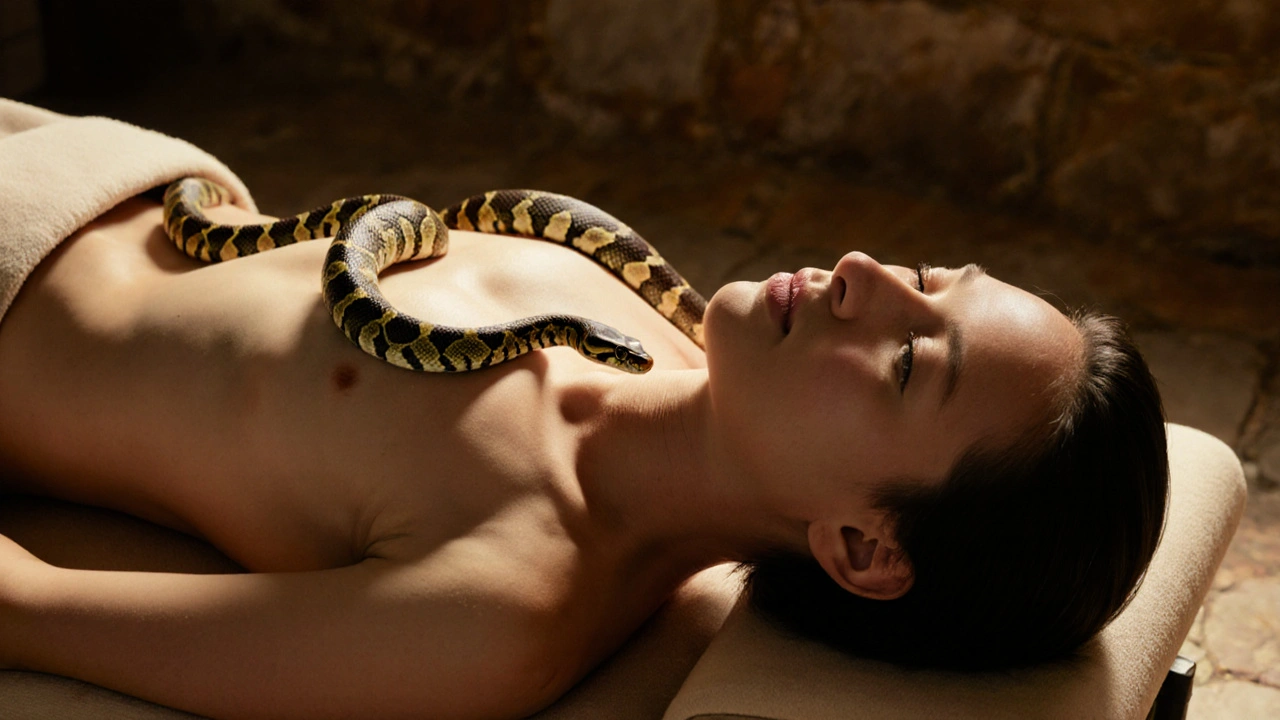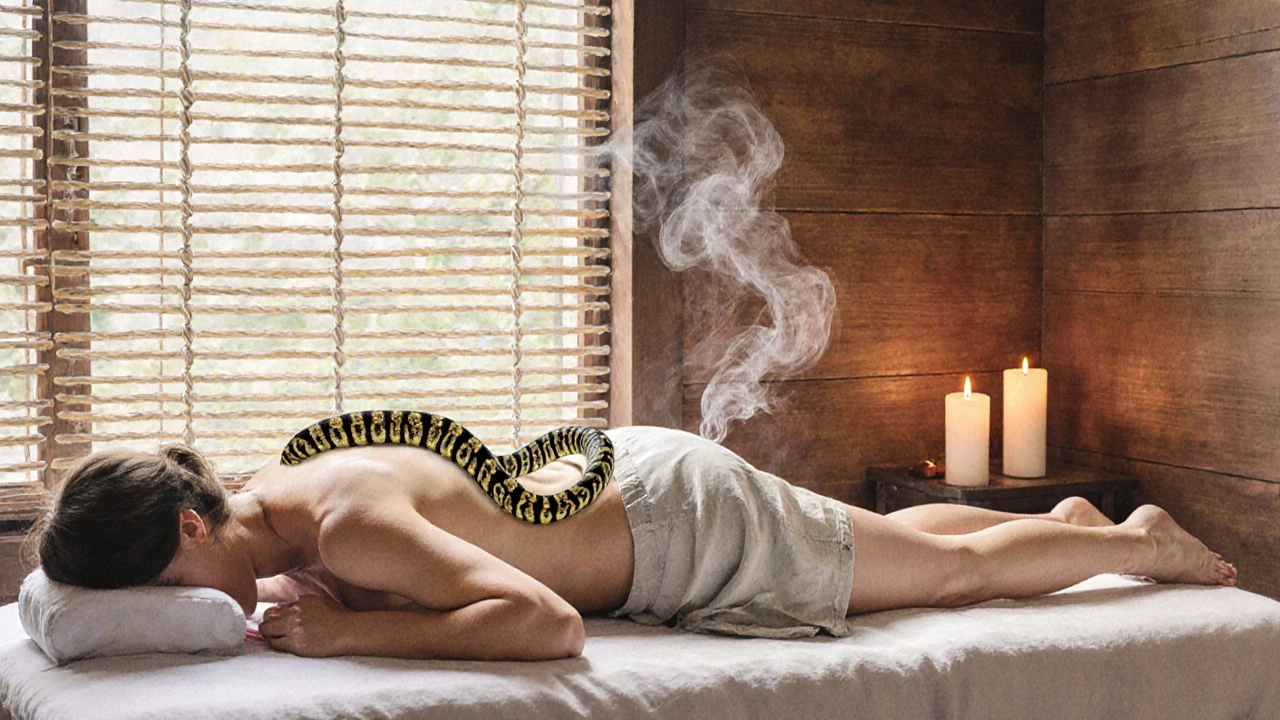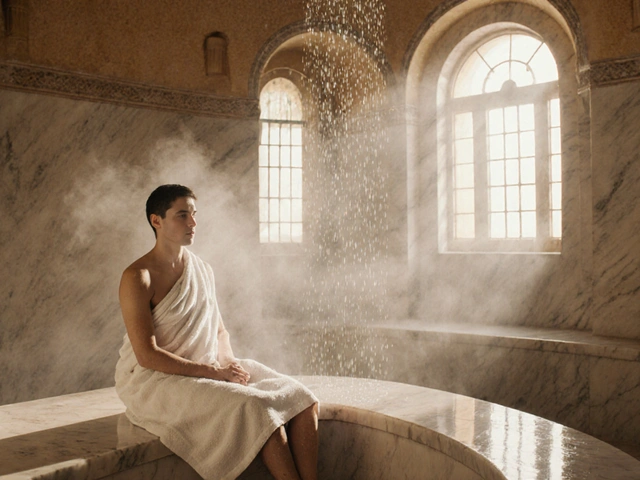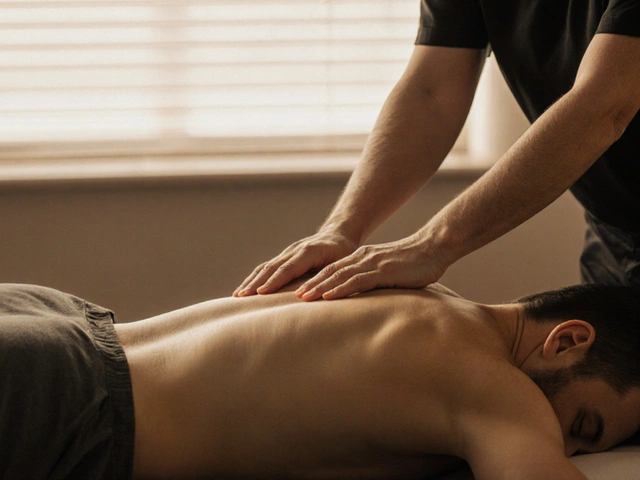Snake Massage: What It Is, How It Works, and Why People Swear By It

Snake Massage Suitability Checker
This tool helps you assess if snake massage might be suitable for you based on your health conditions and comfort level. Snake massage is a unique wellness practice that may offer deep relaxation, but it's not appropriate for everyone.
Imagine lying on a warm table, eyes closed, breathing slow-and then you feel it. A smooth, cool ripple glides across your back. Not a hand. Not a roller. A live snake. No, this isn’t a horror movie. It’s snake massage, and it’s real. More people are trying it every year, especially in places like Thailand, Bali, and even boutique wellness centers in Sydney. If you’ve heard about it and thought, ‘That’s weird,’ you’re not alone. But weird doesn’t mean useless. In fact, for many, it’s one of the most calming experiences they’ve ever had.
What Exactly Is Snake Massage?
Snake massage, also called snake therapy, is a form of bodywork where non-venomous snakes-usually royal pythons or ball pythons-are gently placed on a person’s bare skin during a massage session. The snakes move naturally, sliding over the back, shoulders, arms, and legs. The therapist controls the environment, not the snake’s movements. You don’t hold them. You don’t touch them. You just let them be.
These snakes aren’t trained to massage. They don’t know what they’re doing. And that’s the point. Their movement is random, unpredictable, and deeply soothing. It’s not about pressure or technique like Swedish or deep tissue. It’s about sensation, presence, and letting go.
Most sessions last 20 to 30 minutes. You’re usually fully clothed on the bottom, wearing shorts or a skirt, and topless or in a sports bra. The room is warm-around 28°C-so the snake is comfortable. The therapist places one or two snakes on your back, and you lie still. That’s it.
Why Do People Do It?
People don’t go for snake massage because they think it’s a cure for back pain or a miracle detox. They go because it feels unlike anything else. The sensation is subtle but powerful. The snake’s scales glide over your skin like silk and sandpaper at the same time. It’s cool, smooth, and slightly textured. The rhythm is slow, rhythmic, and hypnotic.
Many clients report deep relaxation within minutes. Some say it’s like being hugged by a living blanket. Others describe it as a meditation made physical. One woman in Chiang Mai told me she cried during her session-not from fear, but because she hadn’t felt that calm in years.
There’s no scientific proof that snake massage reduces cortisol or boosts endorphins. But there’s plenty of anecdotal evidence. People with anxiety, PTSD, or chronic stress say it helps them reconnect with their bodies. For those who struggle with touch-due to trauma or sensory overload-the snake’s non-human presence feels safer than a human hand.
How Does It Compare to Other Massage Therapies?
Traditional massage works by applying pressure, kneading muscles, or stretching tissue. Thai massage uses assisted yoga poses. Hot stone massage relies on heat. Snake massage? It doesn’t do any of that.
Here’s how it stacks up:
| Method | Pressure | Therapist Involvement | Primary Effect |
|---|---|---|---|
| Swedish Massage | Light to medium | High | Relaxes muscles, improves circulation |
| Deep Tissue | Heavy | High | Breaks up knots, targets chronic tension |
| Hot Stone | Medium | Medium | Warms tissues, promotes relaxation |
| Snake Massage | None | Low (only placement) | Calms nervous system, reduces mental chatter |
The biggest difference? Snake massage doesn’t ask you to do anything. No breathing exercises. No talking. No stretching. You just lie there and let something else take over. For people who are always in control-busy professionals, caregivers, perfectionists-that’s the gift.

Is It Safe?
Yes, if done right. The snakes used are non-venomous, well-fed, and handled daily. They’re not wild. They’re bred in captivity and used to human contact. Most are under 1.5 meters long and weigh less than 2 kilograms. They’re not interested in you. They’re just looking for warmth.
Reputable centers follow strict hygiene rules. The table is cleaned between clients. The snakes are washed and checked for health before each session. No one is allowed to handle the snakes unless they’re trained. The therapist stays nearby at all times.
There are a few people who shouldn’t try it. If you have a severe phobia of snakes, it’s not for you. If you’re pregnant, most places won’t allow it-though some offer modified versions with one small snake on the legs only. If you have open wounds, eczema, or a compromised immune system, skip it.
One client in Bali told me she almost canceled because she was scared. But the therapist let her hold a snake first. Just for 10 seconds. That tiny moment changed everything. ‘It wasn’t scary,’ she said. ‘It was just… quiet.’
What Happens During a Session?
Here’s what a typical session looks like:
- You arrive and chat with the therapist for 5 minutes. They ask about your comfort level, any fears, or past trauma.
- You change into provided clothing and lie face-down on a heated table.
- The therapist places one or two snakes gently on your upper back. They start near your shoulders.
- You close your eyes. You breathe. The snake moves. Sometimes it curls. Sometimes it slithers slowly down your spine.
- After 20 minutes, the therapist carefully removes the snakes and offers you water.
- You rest for 5 minutes. No talking. Just stillness.
Most people feel lighter afterward. Not physically-no one’s muscles are pounded-but mentally. Like a weight lifted from the inside.

Where Can You Try It?
Snake massage isn’t everywhere. It’s still niche. But it’s growing. In Thailand, it’s common in Chiang Mai and Pai. In Bali, several wellness retreats offer it. In Australia, a few studios in Melbourne and Sydney have started experimenting with it.
Look for places that specialize in alternative therapies or holistic wellness. Ask if they use captive-bred, non-venomous snakes. Check reviews. If the place doesn’t explain their process or seems sketchy, walk away. This isn’t a carnival act. It’s a quiet, intentional experience.
One Sydney studio, The Still Point, started offering snake massage last year. Their founder, a former yoga teacher, said she tried it in Thailand and couldn’t stop thinking about it. ‘It wasn’t about the snake,’ she told me. ‘It was about what it helped me release.’
Is It Worth It?
It costs between $80 and $150, depending on location and session length. That’s more than a regular massage. But you’re not paying for muscle work. You’re paying for a rare kind of stillness.
Is it worth it? That depends on what you need. If you’re looking for relief from a stiff neck, get a physio. If you’re looking for peace, for a moment where your mind stops racing and your body just… is-then maybe.
One man in Sydney, a corporate lawyer who’d been on antidepressants for five years, said snake massage helped him stop taking them. Not because it cured his depression, but because it gave him a new way to feel safe in his own skin. He still goes once a month. ‘It’s my reset button,’ he said.
You don’t have to believe in it to benefit from it. You just have to be willing to lie still and let something strange be gentle with you.





